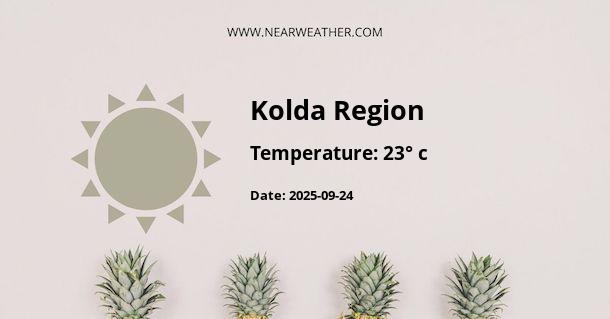Climate and Weather in the Kolda Region, Senegal
The Kolda Region is located in the southern part of Senegal, bordering Guinea-Bissau and Guinea. With its diverse landscape and rich agricultural resources, the region experiences a unique climate and weather patterns throughout the year. Understanding the climate and weather conditions in the Kolda Region is essential for residents, farmers, and visitors alike. Let's take a closer look at the climate and weather in this region.
Geographical Factors
The Kolda Region is situated in the southern part of Senegal, within the Lower Casamance region. It is characterized by a mix of savannah, dense forests, and rivers. The region's proximity to the Atlantic Ocean and the Guinea Highlands significantly influences its climate and weather patterns.
Temperature
The Kolda Region experiences high temperatures throughout the year. The average annual temperature ranges from 25 to 29 degrees Celsius (77 to 84 degrees Fahrenheit). The hottest months are typically from March to May, with temperatures often exceeding 35 degrees Celsius (95 degrees Fahrenheit). The coolest months are from December to February, with temperatures dropping to around 20 degrees Celsius (68 degrees Fahrenheit) at night.
Rainfall
The Kolda Region has a distinct wet and dry season. The region receives the majority of its rainfall during the wet season, which extends from June to October. The average annual rainfall in the region ranges from 1,000 to 1,500 millimeters (39 to 59 inches). The heaviest rainfall occurs in August and September, with occasional thunderstorms and heavy downpours.
During the dry season, which lasts from November to May, rainfall is significantly reduced. The region experiences a period of drought, with little to no precipitation. This dry season plays a crucial role in the agricultural calendar, as farmers rely on irrigation and water management techniques to sustain their crops.
Humidity
The Kolda Region has relatively high humidity levels, especially during the wet season. Humidity ranges from 70% to 90% during this period, creating a muggy and humid environment. In the dry season, the humidity levels drop to around 40% to 60%, providing some relief from the intense heat.
Wind Patterns
The Kolda Region experiences moderate wind patterns throughout the year. The prevailing winds blow from the northeast, influenced by the Harmattan winds from the Sahara Desert. These winds bring dry and dusty conditions, particularly during the dry season. However, during the wet season, the winds shift to a more southerly direction, bringing moisture-laden air from the Atlantic Ocean.
Climate and Agriculture
The climate in the Kolda Region plays a significant role in the region's agriculture. The combination of high temperatures, ample rainfall, and fertile soil creates favorable conditions for various crops. Farmers in the region cultivate crops such as rice, millet, maize, peanuts, and vegetables.
The wet season provides ample water for irrigation and natural growth, supporting the growth of crops. However, the dry season poses challenges for farmers, as they rely on irrigation techniques and water conservation methods to sustain their crops. The Kolda Region's climate requires careful planning and adaptation in agricultural practices to ensure successful harvests.
Climate Change and Adaptation
Like many regions around the world, the Kolda Region is also experiencing the impacts of climate change. Rising temperatures, changing rainfall patterns, and increased frequency of extreme weather events pose challenges for the region's agriculture, water resources, and overall livelihoods.
Efforts are being made to adapt to these changes and mitigate their effects. These include promoting sustainable agricultural practices, improving water management systems, and implementing climate-smart initiatives. By adopting these measures, the Kolda Region can enhance its resilience to climate change and ensure the well-being of its communities.
Conclusion
The Kolda Region in Senegal experiences a distinct climate and weather pattern, characterized by high temperatures, a wet and dry season, and significant agricultural significance. Understanding the climate and weather conditions in the region is crucial for residents, farmers, and policymakers to make informed decisions and adapt to the changing climate. By embracing sustainable practices and climate-smart initiatives, the Kolda Region can navigate the challenges posed by climate change and ensure a sustainable future.
A - Kolda Region's Latitude is 12.983760 & Longitude is -14.397290.
A - Weather in Kolda Region is 23° today.
A - Climate Conditions in Kolda Region shows light rain today.
A - Humidity in Kolda Region is 98% today.
A - Wind speed in Kolda Region is 8.39 km/h, flowing at 297° wind direction. today.
